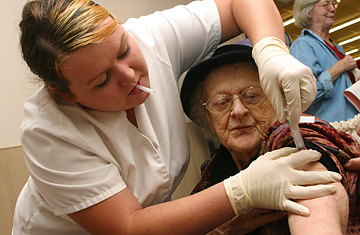
A woman receiving a flu shot
Americans put themselves at needless risk of disease by failing to get key vaccinations as adults, according to a survey by the Centers for Disease Control and Prevention (CDC). The survey also suggests the top reason that adults avoid vaccines: They don't even know they exist.
According to the National Immunization Survey, conducted last summer with responses from 7,000 Americans, the flu shot is the only recommended adult vaccine that most Americans could name. Only 3% to 18% could name each of the others, which include pneumococcal disease; hepatitis A; hepatits B; tetanus, diphtheria, and pertussis; meningococcal disease; and shingles. Less than 10% of respondents remembered that hepatitis vaccines were recommended, and less than 5% mentioned the new shingles vaccine. "We really need to get beyond the mentality that vaccines are for kids," U.S. Assistant Surgeon General Anne Schuchat told a news conference Wednesday. "Vaccines are for everybody."
National adult immunization rates reflect that "kids only" mentality, with rates being lowest for the newer vaccines. According to the survey, just 2% of adults have had the new combo shot for tetanus, diphtheria and pertussis (better known as whooping cough), even though pertussis rates in adolescents and adults have soared in the last 20 years. The disease, a major child killer before the childhood vaccine was introduced, can cause coughing so forceful it breaks a patient's ribs or leaves him vomiting.
The shingles vaccine has been available since 2006, but to date, only 2% of Americans 60 and over have been vaccinated against the disease, an extremely painful condition caused by the chickenpox virus that hits 1 million new patients a year — almost half of all unvaccinated adults who live to 85. Getting vaccinated also means avoiding the risk of post-herpetic neuralgia (PHN), which people with shingles sometimes develop, causing debilitating pain for months or even years.
The survey also found that despite clamorous public debate and high-profile media coverage about the first cancer vaccine, which protects against the human papilloma virus, only about 10% of young women reported receiving at least one dose of the three-dose vaccine. Even for the well-publicized flu vaccine, immunization rates are far below national targets. The CDC wants 90% coverage among at-risk Americans: adults over 50, people with certain existing conditions like heart or lung disease, dormitory or chronic-care-facility residents and workers, people who work or live with small children, and — especially — healthcare workers, who can spread the disease easily. Influenza kills an estimated 36,000 people in the U.S. every year — more than prostate cancer or AIDS — but the current rate for the target group is less than 70%. That's only slightly higher than the rate of vaccination for pneumococcal disease, which sends 175,000 Americans to the hospital every year.
It can be tough to concentrate on healthy living before sickness rears its head. But just like eating well and exercising, public-health officials say, vaccines should be a cornerstone of preventive medicine. "They can prevent serious illness and death. They can save money and help keep us healthy, and at work and able to take care of our families, says Schuchat, who is also director for the CDC's National Center for Immunization and Respiratory Diseases. "We obviously have a lot of work to do and it involves literally rolling up our sleeves."
Check out the CDC's immunization schedule, and the next time you visit your doctor, ask about routine vaccinations.
